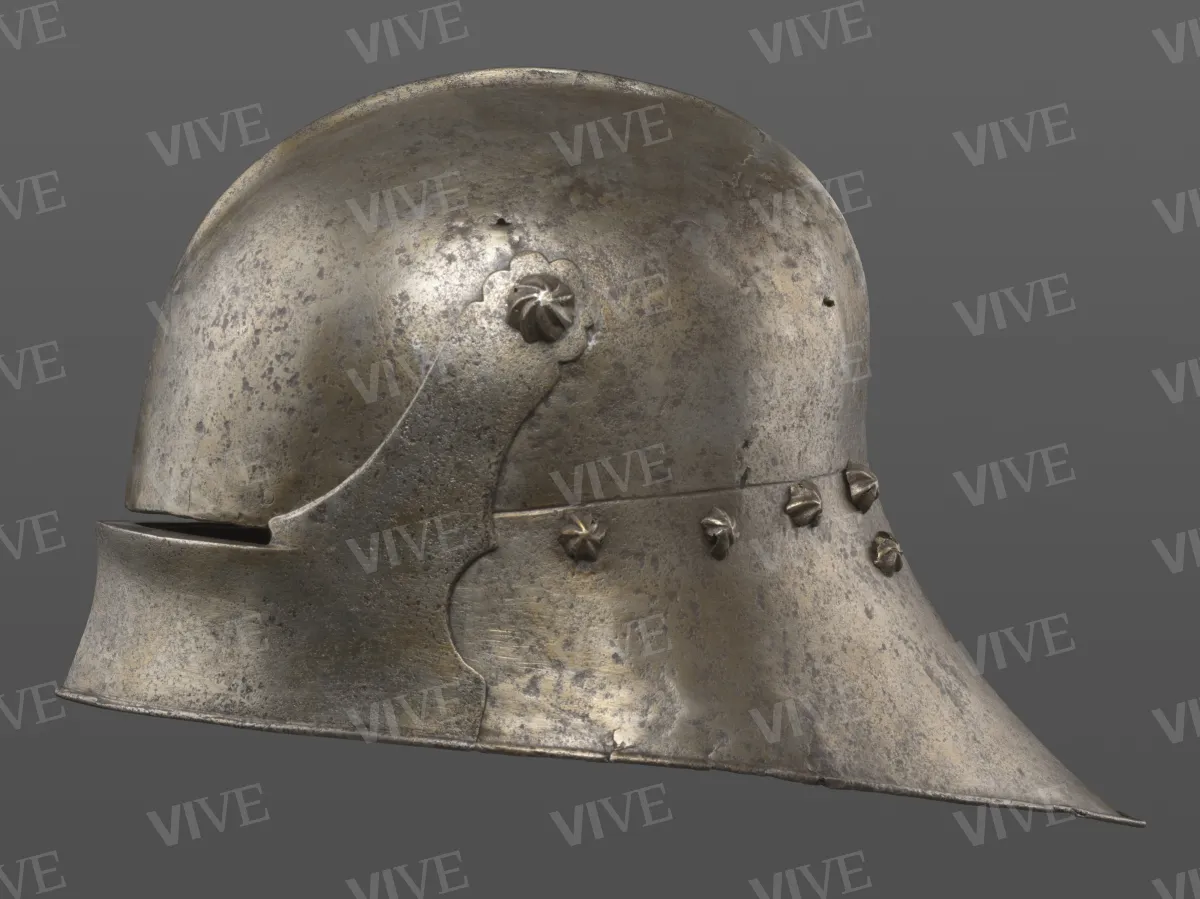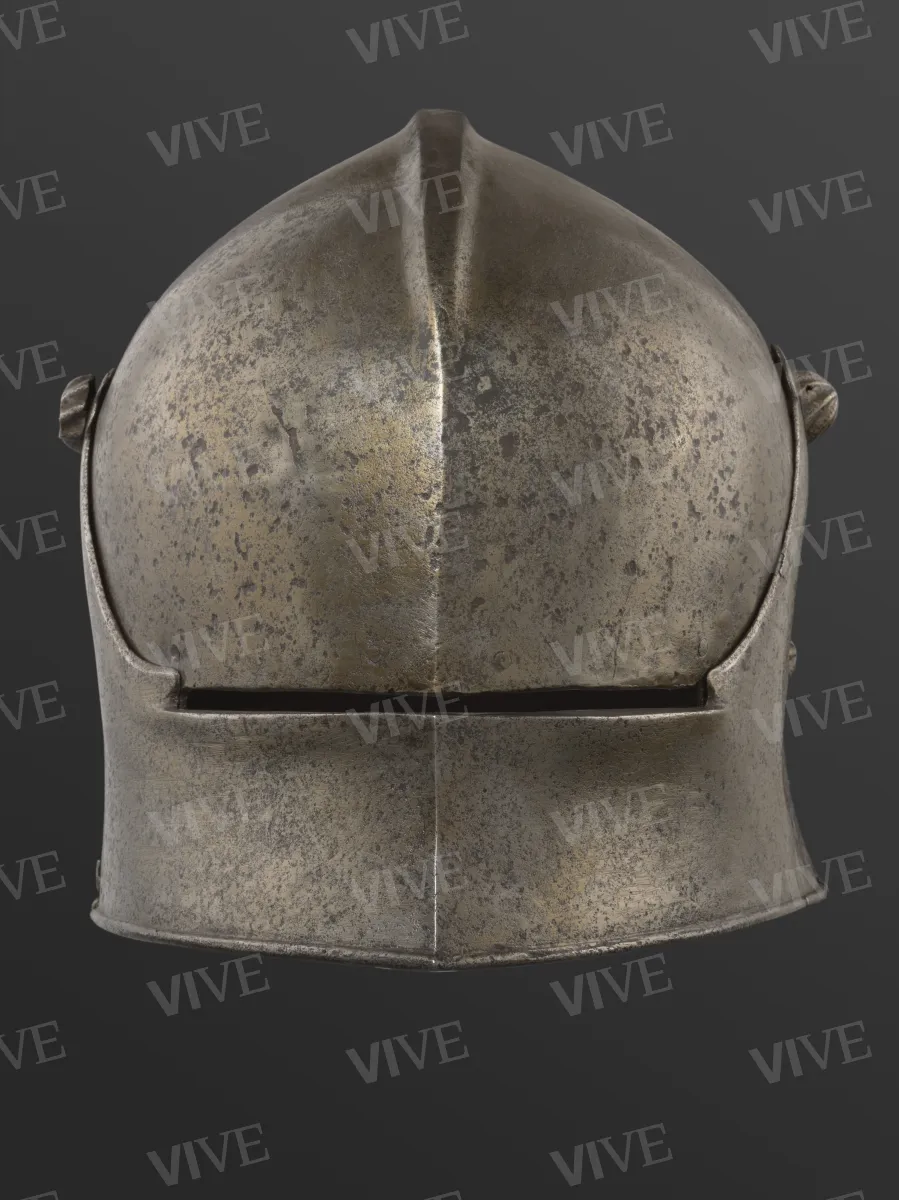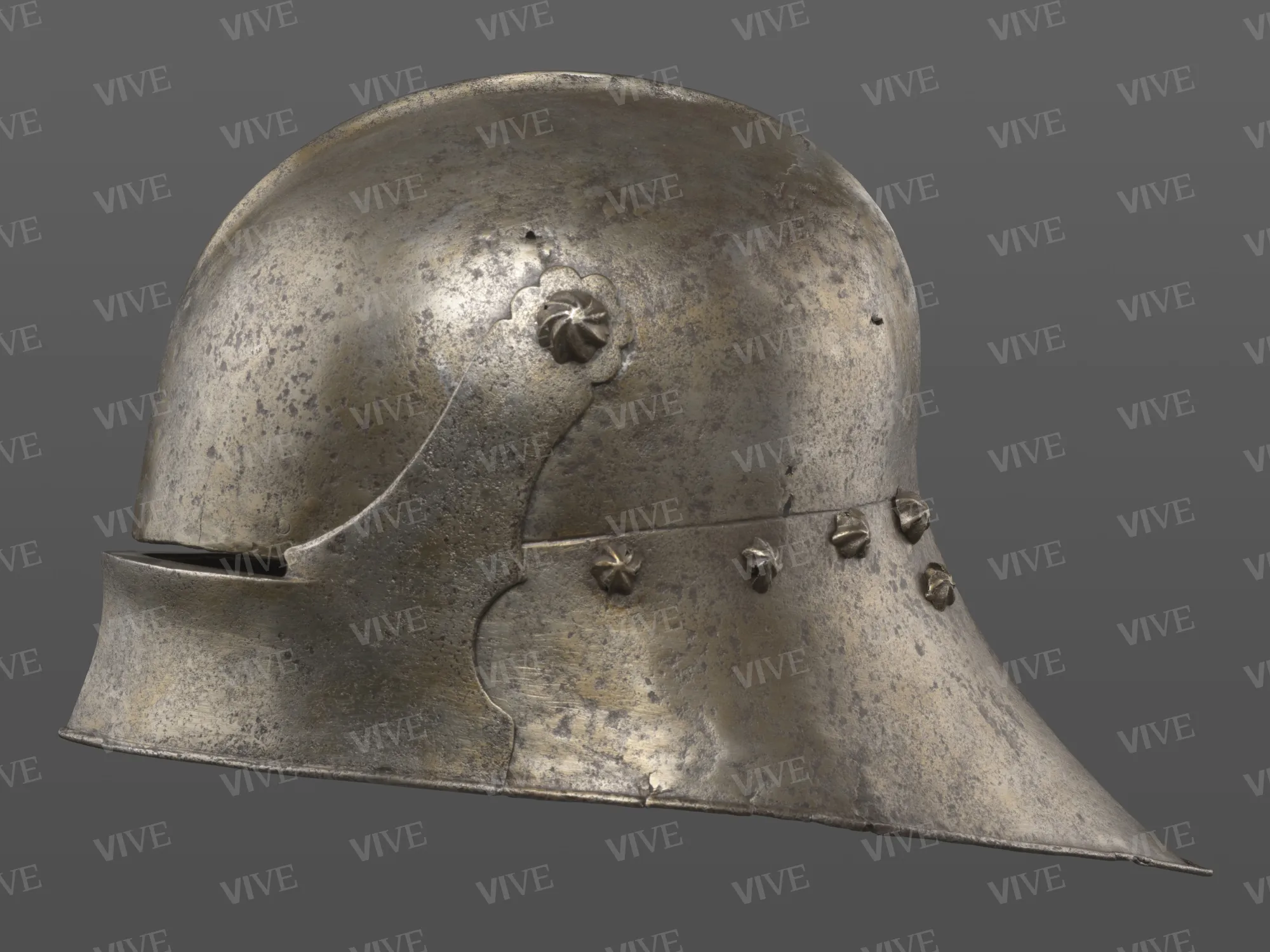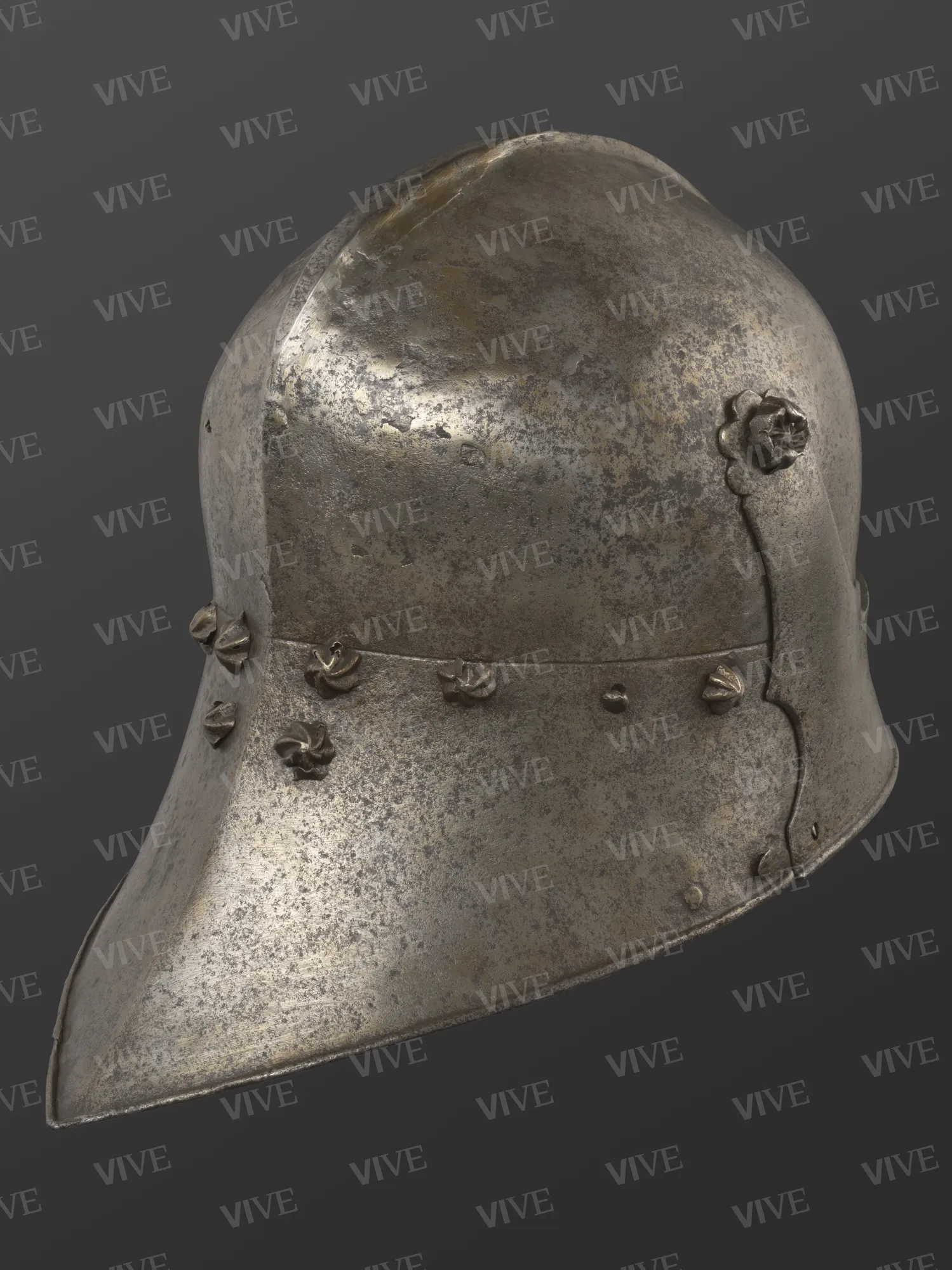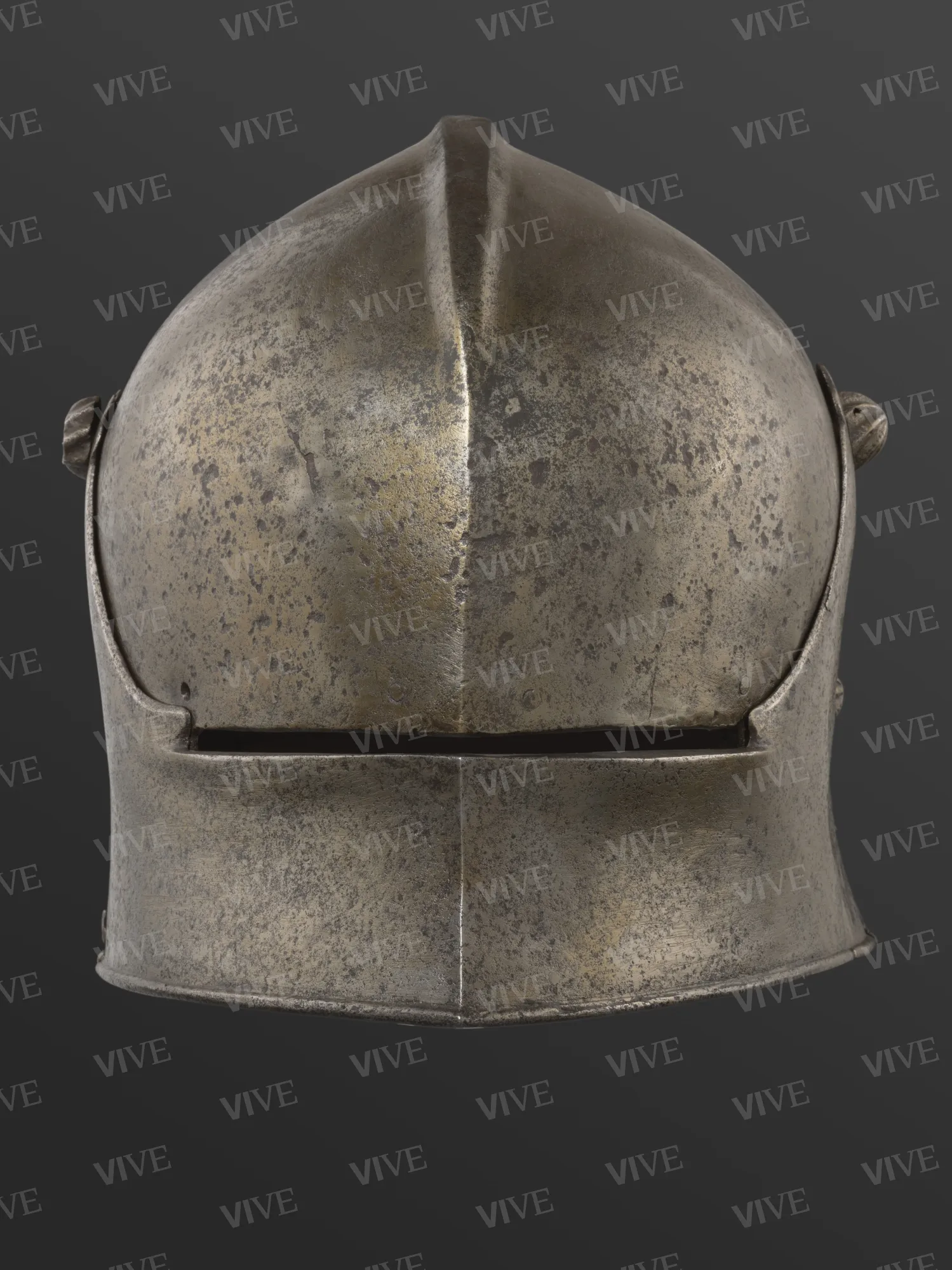Fan-shaped sallet
Workshop of Adrian Treytz the Elder 1480–1490
The sallet, a war helmet employed during the fifteenth century, served to safeguard the soldier‘s head. This particular specimen, crafted in Austria and distinguished by rivets shaped like six-pointed stars, exhibits a straightforward design. It comprises two components: the skull, featuring an elongated point to shield the nape of the neck, and the fan or visor, which could be elevated for practicality or lowered during combat, providing a narrow slit for visibility.
The sallet, a war helmet employed during the fifteenth century, served to safeguard the soldier‘s head. This particular specimen, crafted in Austria and distinguished by rivets shaped like six-pointed stars, exhibits a straightforward design. It comprises two components: the skull, featuring an elongated point to shield the nape of the neck, and the fan or visor, which could be elevated for practicality or lowered during combat, providing a narrow slit for visibility.
Details of work
Catalog entry
This sallet features a skull with a slight ridge, to which a movable visor is hinged by means of a flap shaped like a flower, secured to the helmet with a rivet stamped with a star (di Carpegna 1969, p. 9, n. 31; di Carpegna 1976, p. 9). Additionally, some of the rivets (or vervelles) along the lower part of the roof tile are convex and star-shaped, used to secure the inner lining, referred to as "a bozzetta" in fourteenth-century documents. The visor appears to be an antique addition from the nineteenth century, as it does not provide the necessary slit for vision when lowered—this feature is evident in a similar sallet (inv. 12063). Furthermore, the lower edge of the visor is open and not properly closed (Scalini 2018, p. 229, n. VIII.4).
The sallet is a type of war helmet used across Europe during the fifteenth century, particularly in the Germanic region, as demonstrated by its depiction in Albrecht Dürer’s engravings. Initially produced in simple and functional designs from the early fifteenth century, they reached a notable level of aesthetic refinement by the mid-16th century when prominent artists contributed to their design (Pyhrr 2000). Unlike other helmets, which were heavier and bulkier, the sallet did not feature a high crest but rather included a simple fan that could be raised if necessary. It was an evolution of single-piece helmets (inv. 12050; Gelli 1900, pp. 81–91; Oakeshott 2012, pp. 109–116).
This sallet, similar to many others from Austria or southern Germany, features six-pointed star-shaped rivets. These rivets are identical to those on a similar example (of the single-block type without a fan) housed at the Metropolitan Museum of Art in New York (inv. 04.3.229; La Rocca 2017, p. 54). It has been attributed to Austrian gunsmith Adrian Treytz the Elder, active in Innsbruck between 1473 and 1492, due to the recognition of the brand. In the absence of a maker’s mark, this helmet can be attributed to his workshops or other workshops in Innsbruck thanks to the particular star rivets.
Similar "a bozzetta" elements are also found on a helmet in the Philadelphia Museum of Art (Breiding 2020, pp. 60–61, n. 12), formerly owned by Carl Otto Kretzschmar von Kienbusch. He was involved in acquisitions along with Prince Ladislao Odescalchi (1846–1922), from whose collection this piece originated. The Italian State acquired the collection in 1959 and relocated it to Palazzo Venezia in 1969. It was not a family armory but was assembled through specific purchases in both national markets (Florence, Rome) and international markets (Paris, London) starting in the late nineteenth century, influenced by Odescalchi’s personal preferences (Barberini 2007).
Giulia Zaccariotto
Entry published on 27 March 2025
State of conservation
Fair.
Provenance
Rome, Ladislao Odescalchi Collection (Odescalchi, no. 758);
acquired by the Italian State, 1959;
Rome, Museo Nazionale di Palazzo Venezia, 1969.
Exhibition history
Rome, Museo Nazionale di Palazzo VeneziaAntiche armi dal sec. IX al XVIII. Già Collezione Odescalchi, May–July 1969;
Rome, Museo Nazionale di Castel Sant’Angelo; Rome, Museo Nazionale di Palazzo Venezia, Armi e potere nell’Europa del Rinascimento, July 26–November 11, 2018.
References
Gelli Jacopo, Guida del raccoglitore e dell’amatore di armi antiche, Milano 1900;
di Carpegna Nolfo (a cura di), Antiche armi dal sec. IX al XVIII. Già Collezione Odescalchi, catalogo della mostra (Roma, Museo Nazionale di Palazzo Venezia, maggio-luglio 1969), con schede a firma del curatore, Roma 1969, p. 9, n. 31;
di Carpegna Nolfo, Le armi Odescalchi, Roma 1976;
Pyhrr Stuart W., European Helmets, 1450-1650. Treasures from the Reserve Collection, New York 2000;
Barberini Maria Giulia, La collezione Odescalchi di armi antiche: storia della raccolta del principe Ladislao, in «Bollettino d’arte», s. VI, XCI, 2006 (2007), 137/138, pp. 101-114;
Fossà Bianca, Studio conservativo delle armi e armature Odescalchi. Nuove metodologie per la schedatura di una collezione, in «Bollettino d’arte», s. VI, XCI, 2006 (2007), 137/138, pp. 115-142;
Oakeshott Ewart, European Weapons and Armor. From the Renaissance to the Industrial Revolution, Woodbridge 2012;
Pyhrr Stuart W., Of Arms and Men. Arms and Armor at the Metropolitan 1912-2012, New York 2012;
La Rocca Donald J., How to Read European Armor, New York 2017;
Scalini Mario (a cura di), Armi e potere nell’Europa del Rinascimento, catalogo della mostra (Roma, Museo Nazionale di Castel Sant’Angelo; Roma, Museo Nazionale di Palazzo Venezia, 26 luglio-11 novembre 2018), con schede a firma del curatore, Cinisello Balsamo 2018, p. 229, n. VIII.4;
Breiding Dirk H., Arm and Armor. Highlights from the Philadelphia Museum of Art, Philadelphia 2020.

